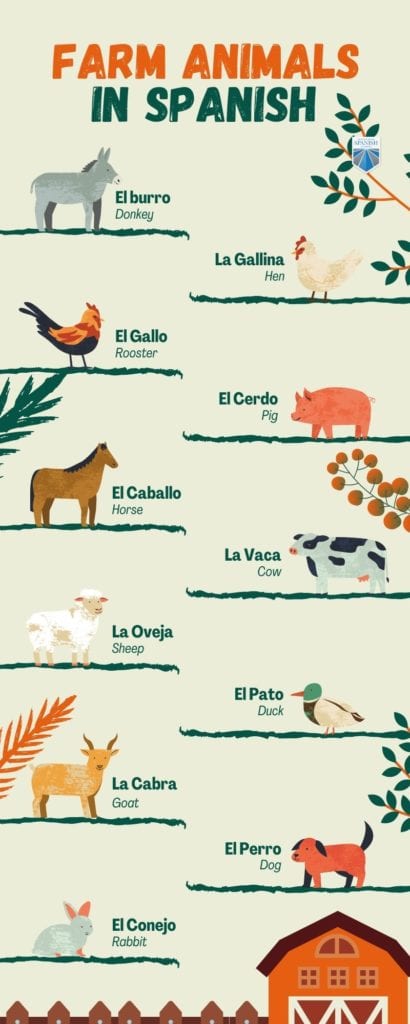Navigating the vast tapestry of a foreign language can feel like an adventure into uncharted territory. As you seek to master Spanish, understanding the nuances of seemingly familiar words becomes an essential step. One such word is “farm,” which may seem straightforward but holds a hidden complexity in its translation.

Image: www.spanish.academy
Join us on this linguistic expedition as we explore the intricacies of “farm” in Spanish, delving into its historical roots, cultural significance, and modern-day usage. With a blend of linguistic precision and cultural insights, we aim to decode the mysteries of this seemingly simple word.
The Enigmatic “Granja”: A Historical Perspective
In the realm of Spanish agriculture, the term “granja” reigns supreme, evoking visions of sprawling fields and rustic farmhouses. Its etymological journey traces back to the Latin word “grangia,” meaning “barn” or “farmhouse.” This humble origin reflects the practical nature of Spanish rural life, where the barn served as the heart of agricultural operations.
As centuries passed, “granja” evolved beyond its humble beginnings to encompass the broader concept of a farm, including all its associated activities and structures. Today, the word embraces everything from cattle ranches to poultry farms, showcasing the diverse panorama of Spanish agriculture.
Beyond “Granja”: Unveiling the Domain of “Finca”
While “granja” captures the essence of a working farm, the Spanish language has another word that further enriches the agricultural vocabulary: “finca.” Its Latin roots, meaning “property” or “estate,” hint at its broader scope.
In modern Spanish, “finca” encompasses a wide range of land-based properties, including farms, ranches, orchards, vineyards, and even forests. Its versatility extends to encompass not just agricultural ventures but also vacation homes and rural retreats. Understanding the subtle distinction between “granja” and “finca” opens doors to a deeper understanding of Spanish land ownership culture and the diverse uses of property.
Bridging the Gap: Exploring the Nexus of “Hacienda” and “Estancia”
As we delve further into the realm of Spanish agriculture, two additional terms emerge: “hacienda” and “estancia.” While they share similarities with “granja” and “finca,” they possess unique characteristics that warrant exploration.
“Hacienda,” tracing its lineage back to the Latin word “facere” (to do or make), originally referred to any type of rural property. However, over time, it has come to be associated specifically with large, plantation-style estates, often with a focus on cash crops. “Estancia,” on the other hand, finds its roots in the Spanish verb “estar” (to be) and typically denotes a sprawling ranch dedicated to livestock grazing. Both “hacienda” and “estancia” reflect the vast agricultural landscapes of Spain and Latin America, adding depth and diversity to the Spanish agricultural lexicon.

Image: www.madebyteachers.com
Tips and Expert Advice for Navigating the Agricultural Spectrum
Now that we have unraveled the intricacies of “farm” in Spanish, let’s delve into some practical tips and expert advice to solidify your understanding:
– When referring to a farm primarily engaged in crop production, “granja” is the most appropriate term.
– For a property encompassing a broader range of activities, including both agriculture and non-agricultural pursuits, “finca” is the preferred choice.
– To describe a large, plantation-style estate focused on cash crops, “hacienda” is the most suitable term.
– When describing a sprawling ranch dedicated to livestock grazing, “estancia” is the accurate choice.
Frequently Asked Questions: Unraveling the Vocabulary of Spanish Agriculture
Q: What is the most common term for “farm” in Spanish?
A: “Granja” is the most commonly used term for “farm” in Spanish, denoting a working farm primarily focused on crop production.
Q: What is the difference between “granja” and “finca”?
A: “Granja” specifically refers to farms engaged in agricultural activities, while “finca” encompasses a broader range of land-based properties, including farms, ranches, orchards, vineyards, forests, vacation homes, and rural retreats.
Q: What is the historical origin of the word “granja”?
A: “Granja” traces its roots back to the Latin word “grangia,” meaning “barn” or “farmhouse,” highlighting its practical roots in Spanish rural life.
How To Say Farm In Spanish
Conclusion: Unveiling the Nuances, Embracing the Language
Our journey into the complexities of “farm” in Spanish has illuminated the rich tapestry of agricultural vocabulary, revealing the subtle nuances and historical roots that shape our understanding of this essential word.
As you continue your exploration of the Spanish language, remember the nuances of “granja,” “finca,” “hacienda,” and “estancia.” Embrace the cultural context and historical evolution of these terms, for they hold the key to unlocking a deeper appreciation of Spanish agriculture and the diverse landscapes it encompasses.
We invite you to continue your linguistic journey, exploring the myriad words and phrases that paint the vibrant canvas of the Spanish language. Embark on conversations, immerse yourself in Spanish literature, and engage with the rich cultural heritage that makes this language so captivating.
Thank you for joining us on this linguistic adventure. We hope it has sparked a newfound appreciation for the intricacies of the Spanish language.